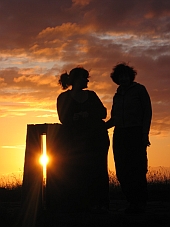Eugene
Astronomical Society Presentation - February 15, 2012
Sun Position Fun
Observing and
understanding the sun's position and movement,
indoors and
outdoors,
day and night

Homework
-
When is the sun highest in the sky and due south today? On February 15? Observe and/or compute.
-
Observe the sun and moon together in the sky, e.g. around first quarter. Should the illumination on the moon point to the sun? Does it? Why or why not?
Handout
Contains solar noon table, equation of time correction table, and plotted analemma
Sun Motions Demonstrator
My Sun Bookmarks
Search page for keywords, topics
Resources and Details (In Progress)
Includes links, notes, corrections, improvements and credits
-
Introduction - easisest star to observe; daytime astronomy, stars; uses; outreach. A Brief History of Telling Time - and Sun Consciousness
- Background - sun movement in stars: chart; sun movement in sky: animation
Solar Time and Noon Mark Project - solar day; equation of time; solar time; noon mark project
-
Daily Movement - declination and hour angle; rise/set: time, azimuth, angle; noon transit; hourly alt/az position and rates
-
Altitude/Azimuth and Astrolabe - ra/dec <-> alt/az; planispheric astrolabe; extend to star movement
-
Finding Direction - primitive direction finding; shadow trace; sun compasses; surveying Oregon
-
Finding Location - noon sight and navigation; bird tracking by photoperiod
-
Analemma - components; earliest/latest sunrise/sunset
-
Sundials - gnomon; types; usability and design; embellishments; Eugene dials
-
Sun At Night - imagination, anti-sun, ecliptic; moon age, moondial; moon illumination
Projects Incorporated Throughout
- Sun Sights - e.g. sunset point, special event
-
Shadow Stick - telling time, curves, finding east-west
-
Analemma - observe sun's position at given time throughout year
-
Sundial - gnomon, time, embellishments
Software Understanding
jh@softwareunderstanding.com
541-505-9980
2165 Adams St Eugene OR 97405
softwareunderstanding.com